Basics: Beginner’s guide to understanding surf leashes
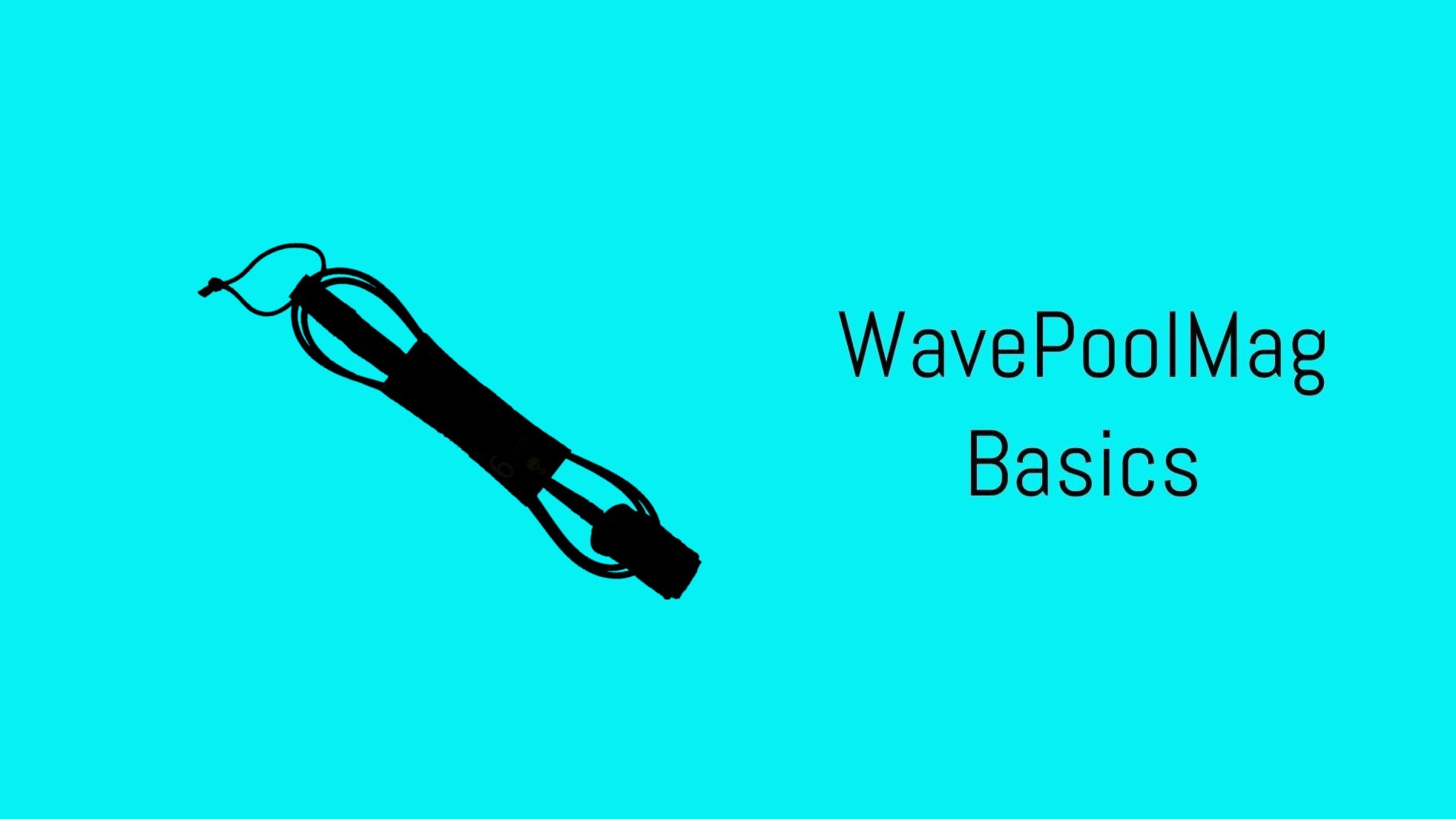
Surf leashes are essential accessories that help prevent the loss of the surfboard. They are designed to be highly durable and easily attach to the surfer’s leg. Many surf leashes feature lightweight, non-slip cuffs and quick release tabs for safety. There are different types of surf leashes designed for each different type of surfing, from competition-level surfing to big wave surfing. Surf leashes come in various thicknesses and lengths to meet the needs of different surfers and choices in board length and shape.
The little known history of surf leashes: Controversy, function and tips
“Those against using the leash claim it isn’t pure and that it destroys the aesthetics of surfing.”
Surf legend/pioneer Corky Carroll penned these words in a 1972 op-ed in Surfer Magazine. While he ultimately came to the conclusion that he would accept the novel invention of the surf leash (legrope for Australians), it was far from a consensus opinion at the time.
Some (correctly) thought it was dangerous. Others thought it would ruin the spirit of surfing. Ultimately, it became commonplace in surfing culture and sped up the progression of the sport. Surfers could be more daring and progressive without having to worry about losing and dinging their boards. The leash allowed for more time surfing and less time swimming.
For most surfers today, wearing a leash is a logical and easy choice. And the technology has come a long way since the first commercially produced leashes of the 70s.
Join us on a ride back in time to understand how this new invention took a hold in the sport, how it became engrained in surf culture, and for tips on how to properly select and use a leash while you are riding waves whether in the ocean or the pool.
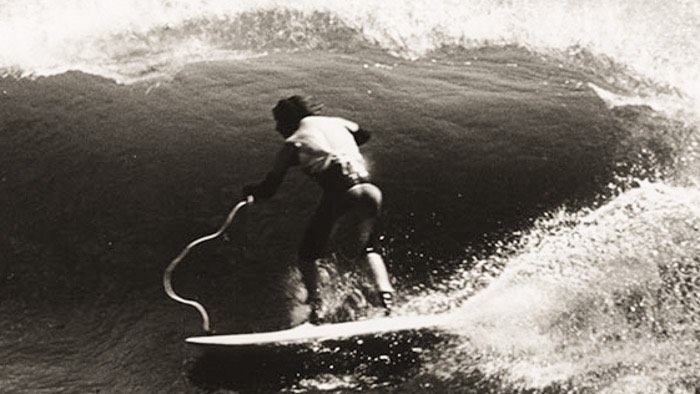
Controversial beginnings: The first leashes
The exact beginnings of the leash are up for debate. Various surfers from France, Australia, and USA all lay claim to having invented the device.
In the 1930’s American surfer Tom Blake tied a 10-foot cotton rope to his waist and connected it to his board. He eventually gave up on the invention, deeming it too dangerous.
Other iterations of what would become a leash appeared in the ’50s and ’60s. In 1958 French surfer George Hennebutte created an elastic line with a double-velcro ankle strap. Still, it never caught on.
Eventually a legendary surf family from northern California was able to get a product into the mainstream.
Rumor has it that Pat O’Neill, the son of the Santa Cruz wetsuit pioneer Jack O’Neill, embraced his father’s innovative approach to surf gear to develop the first commercially viable leash in the 1970s. (Some give this credit to fellow Santa Cruz surfer Roger Adams.)
Pat caused a stir when he showed up at the Malibu Invitation in 1971 to publicly display his new invention. He surfed the competition with a surgical cord wrapped around his wrist attached to the nose of the board with a suction cup. O’Neill believed that aside from keeping his board attached to his body, the cord could also be leveraged to add extra control through his carves.
The surfing community mocked him for his ridiculous contraption. Some called it a ‘kook cord’. Others said it went against the core of surf culture and would allow inexperienced surfers to crowd the lineups.
“They say that if you make a mistake you should pay the price with a swim to the beach, even if it means having your board destroyed against a cliff or jetty,” said Carroll in his 1972 editorial. “They also point out the danger of being hit by your board or having the cord wrapped around your neck.”
However, it wouldn’t be long until the value of a leash would become paramount to surfers – the benefits outweighing the apparent dangers. Ultimately, it was Pat O’Neill who would have the last laugh.
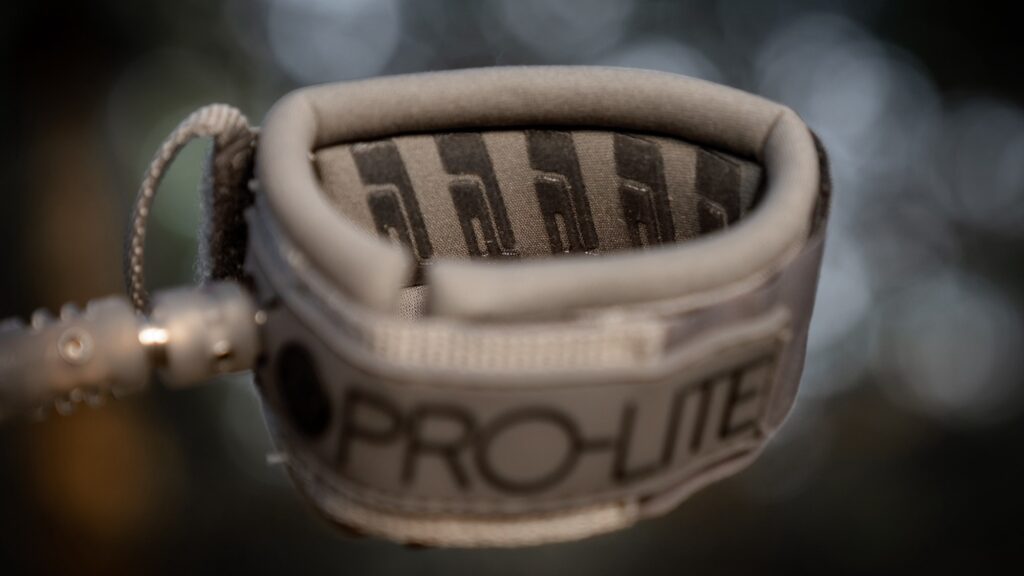
Ushering in the modern surf leash
The leash technology first revealed by O’Neill vastly improved in the coming years. The wrist technology proved to be useful, but dangerous. Jack O’Neill infamously lost an eye in a wrist leash accident where the cord snapped back into his face.
Improved leashes were later attached to the ankle instead of the wrist, anchored to the board at the fin, fin box, and, eventually, the tail instead of the nose to create more freedom of movement.
By the mid 1970s two southern California companies, Control Products and Block Enterprises, were the first to market leashes as commercial products.
“I didn’t like the surgical tubing, the suction cup or the attachment to the wrist,” explained Larry Block of Block Enterprises. “People were jerking their boards around with their hands and it was just horrible. I think that Jack O’Neill losing his eye from it proved that the design and materials were flawed.”
“I used bungee cord because it didn’t stretch out as much and come flying back, and I attached it around my ankle because it wouldn’t affect my surfing at all,” Block added. “I attached the leash through a hole in the fin, which seems crude now, but it was better than the surgical tubing. I did an ad in Surfing Magazine and we wholesaled it for $5.”
The technology continued to develop with ankle straps and fiberglass leash strings added to decks. The first urethane leash was patented in 1977, providing more flexibility and less stretch to avoid boards shooting back at the surfer. It created the base model for what would become the modern leash.
Australian David Hattricks patented the innovative urethane material and won the Australian Design Award in 1979. Soon after velcro ankle straps, “rail savers”, and swivels were added to form the foundation of the leash as we know it today.
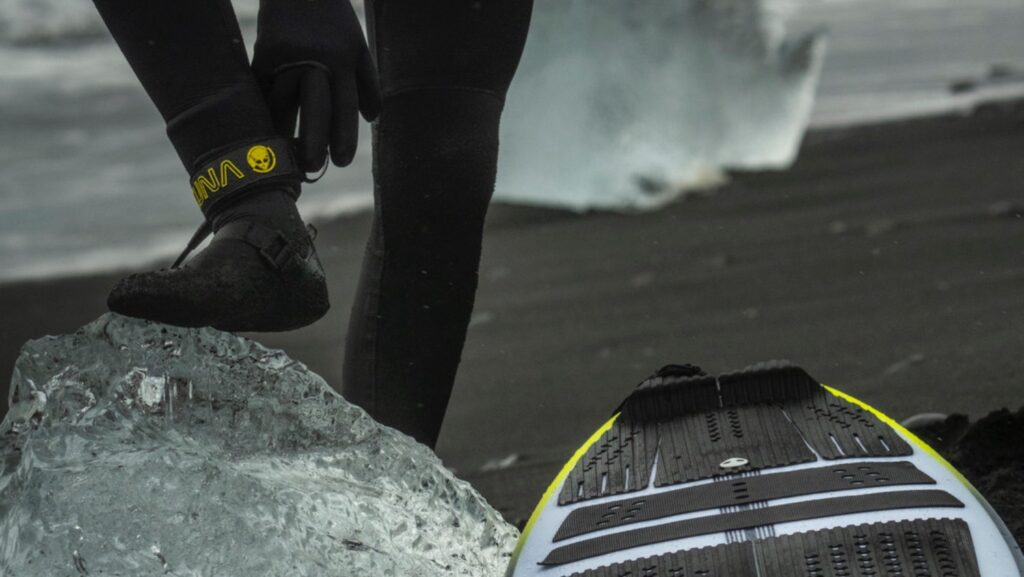
Parts of a leash
After years of innovation, the standard leash consists of six core components. Each has evolved to serve a key purpose.
Cord
The cord is the majority of the length of the leash. Generally made of polyurethane, it is designed to create enough stretch that it will not snap under pressure, but not too much stretch that boards will come rocketing back at the surfer.
Cuff
The cuff is a velcro wrap that connects the surfer to the cord. A sturdy, comfortable cuff is often what differentiates the top leashes from the cheap ones. A surfer who has experienced a wave strong enough to rip off the velcro will greatly appreciate a quality cuff.
Swivel
The swivels are joints on either end of the cord that allows the leash to have a range of movement without getting tangled. Without swivels the leash would inevitably tie into knots and get more easily wrapped around the surfer.
Rail saver
In the early days of product design, the leash cord was attached directly to the deck of the board. The cord is a tough material and would often get pulled in such a way that it sliced through the board.
The solution was the rail saver, a wider, softer piece of material that connects the swivel to the leash string. It is more gentle with the rails of the board.
Leash string
The leash string is technically not part of the leash, but it’s still an integral part of attaching the leash to the board. A leash string is tied into a loop and passed through the leash plug. The rail saver is inserted through the leash string to create its contact point with the surfboard.
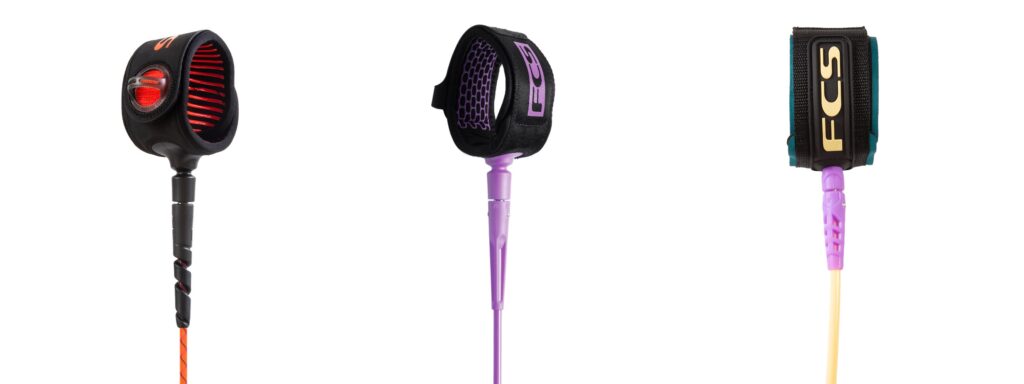
Types of leashes
A leash is not a simple one-size-fits-all product. There are various designs that are better suited to your style of surfing and the type of surf that you intend to use it in. Generally a leash should be about the length of your board, or slightly longer. For example, a standard 6’ shortboard will require at least a 6’ leash. A 9’ foot longboard will need slightly more than a 9’ leash to allow access to the entire board. There are exceptions to this rule, like when surfing big waves.
As a rule of thumb, thicker leashes will be stronger, but create more drag. Thinner leashes will create less drag, but sacrifice strength. Finding the right leash is about knowing the board you surf and the conditions you will be surfing in.
Standard leashes
For the average surfer a standard leash is a nice middleground compromise of minimal drag and reasonable strength. They are typically 6-7mm in thickness. If you are surfing in a range of conditions and have to pick one leash, this is a good style to go with.
Competition leashes
Surfers looking for maximum performance who are not super worried about a potential leash snap can use a competition leash. They are slightly thinner, usually around 5mm thick. Competition leashes are perfect for smaller to medium surf, producing the least amount of drag and less chance that it will get wrapped around your ankles.
Big wave leashes
If you are surfing big waves the priority is staying connected to your board, which can be a lifeline depending on the situation. Thus big wave leashes are the strongest with a thickness of at least 8mm. For big waves a longer leash is used to keep the surfer at a safer distance from the board during a punishing wipeout.
Longboard leashes
Oftentimes longboarders decide to go without a leash to provide more freedom of movement. For those who do opt to attach themselves to the board, the leashes are naturally longer than a shortboard leash to allow the surfer to comfortably walk the length of the board. You’ll often see longboarders use leashes with a wider cuff designed to wrap around the calf, which is less prone to get wrapped around the ankles when cross-stepping.
Coiled leashes
For bodyboarding and StandUp Paddle, a coiled leash makes sense. Bodyboarders typically attached a coiled leash from the front of the board to their bicep, and the coiled design makes for less drag and hindrance. StandUp paddlers also opt for this design to keep the leash out of the water and maximize speed.
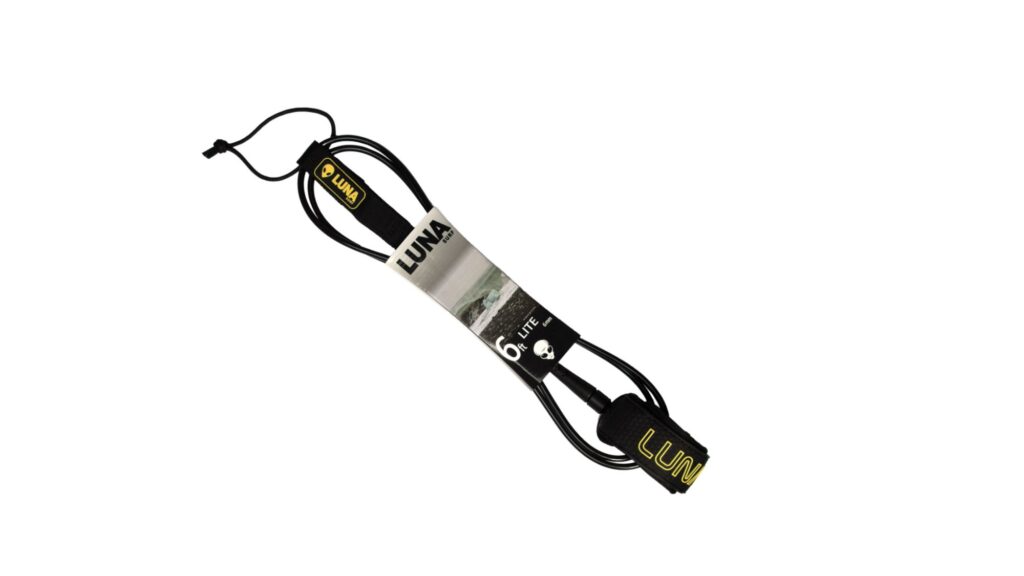
The Do’s and Don’ts of leashes
Attaching a leash to your board and your ankle seems like a straightforward process. However, it is anything but. Knowing how to properly install and use a leash is crucial for staying safe and making sure it performs to its maximum ability.
Here are some key rules to follow:
Back foot!!!
The leash should always be attached to your back foot – right foot for regular footed surfers and left foot for goofys. Many beginners make the mistake of attaching it to the front foot, announcing to all in sight that they have no idea what they are doing. A leash on the front foot will inevitably trip you up while riding waves.
Additionally, when wrapping the cuff around the back foot, make sure that the swivel is facing away from your toes. This will help keep your leash behind your board and not dangerously around your feet.
Is the rail saver doing its job?
It’s important to make sure the leash string is tied at such a length that when the leash is pulled the rail saver comes into contact with the rail. If the leash string is too long, the leash string itself will come into contact with the rail and damage the board.
You’d be surprised how many advanced surfers make this mistake.
Two loops on the leash string
When installing the leash string, push it half way through the leash plug and slide the rail saver through each of the two halves of the protruding loops. Using this technique, as opposed to pulling the string through itself and creating one loop, will create less stress on the leash string and decrease the chances of it snapping.
Don’t let the leash dangle
Leashes are a lifesaver for surfers, but they can also be dangerous – even deadly. When you are wearing a leash out of the water, hold the loose leash in your hand so it does not dangle around your feet. This will decrease your chances of tripping on the leash or the leash catching on any object. It’s especially important when walking on rocks and entering the water in precarious areas. There are numerous examples online of a surfer’s leash catching on a rock as they dive into the ocean. Don’t let that happen to you.
Know how to use the quick release loop
Another danger of wearing a leash is that it can get caught on an obstacle in the water. This can be very dangerous when there is power in the ocean. The leash cuffs have a loop that makes it easy to rip it off if necessary. If you surf long enough you will undoubtedly find yourself in a situation where your leash is caught on a submerged reef or rock and the power of the current makes it impossible to release it. In this case you need to pull the quick release loop and detach your body from the board. Wave pools take every precaution to ensure there are no areas where your leash can snag. Still, it’s good to be ready to pull that loop if necessary.
Don’t let it get waxy
If you use wax on your boards, your leash will inevitably start to pick up some of this sticky material over time. But you can minimize the hassle by not wrapping your leash around the waxy deck. Wrapping the leash around the traction pad of the tail is a better choice, or simply not wrapping the leash at all if the deck only uses wax.
Surf don’t swim
While there are still a few soul surfers who prefer the uninhibited feeling of riding without a leash, the leash debate of the 1970’s is largely over; most surfers prefer the leash’s utility and practicality. In the wave pool, it’s mandatory.
A leash keeps you safely attached to your board, avoiding long swims chasing a runaway vessel and keeps your fellow surfers safe. Wearing a leash will also undoubtedly reduce your trips to the ding repair shop.
Be sure that when selecting your leash you know what product is right for you and that you utilize it in a correct, safe manner. The value of a leash will greatly increase your respect of the predecessors who precariously surfed without them.
Related Coverage
